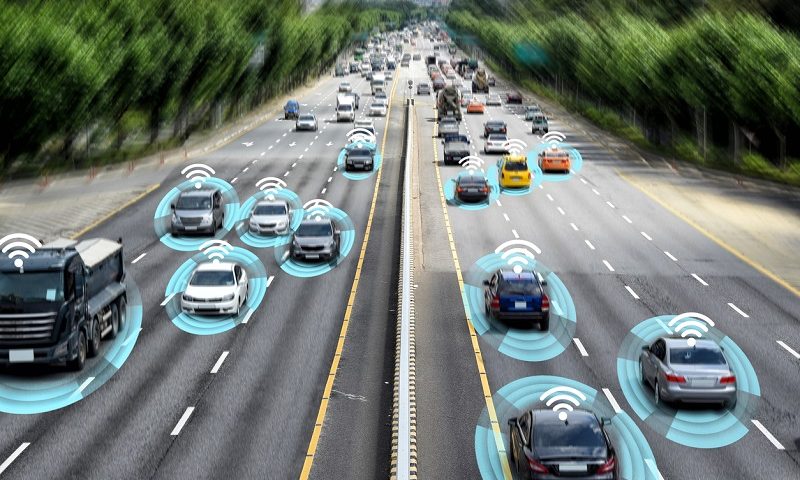How does in-car technology impact our safety on the roads?

When it comes to road safety, in-car technology sparks some mixed feelings.
In fact, according to a survey by Otonomo, as many as 40% of drivers say they don’t feel technology makes them safer behind the wheel at all.
With that in mind, let’s weigh up the benefits and risks…
5 ways technology makes driving safer
Thankfully, vehicle technology has come a long way since the olden days, meaning vehicles are now safer than ever. Here are some of the latest measures manufacturers are adding to their vehicles to protect lives on the road and make driving as painless as possible…
Intelligent Speed Assist (ISA)
According to the European Transport Safety Council (ETSC), 500 deaths every week are caused by drivers going too fast. Now, technology is stepping in to help us tackle the problem.
ISA automatically limits your driving speed, using speed sign-recognition and GPS data to keep you within the limit. Not only will this make you less likely to cause an accident, but could also save you from speeding fines and penalties if you miss a sign.
Did you know, all new cars sold in Europe and the UK will have speed limiters by 2022? Read more about it here.
Lane Keep Assist
Lane detection systems help keep you safe on dual-carriageways and motorways by alerting you if you start to drift lanes. The technology uses sensors that detect nearby vehicles and lane markings to keep you on the straight and narrow.
Some cars also have blind-spot monitoring to help you stay more alert to other drivers when you’re switching lanes.
Driver drowsiness detection
According to Brake, up to 20% of all road crashes can be related to tiredness, with nearly two fifths (37%) admitting they have been worried about falling asleep while driving.
Alertness detection can spot unusual driving patterns such as drifting lanes, sudden deceleration or the angle of your steering wheel. More advanced technologies can even monitor your heart rate to detect when you are growing drowsy.
Automatic Emergency Braking (AEB)
Put simply, AEB is an automatic braking feature that has the power to stop your vehicle without you putting your foot on the brake pedal.
The system works using cameras or sensors to detect close range objects to detect the risk of a collision. If you fail to respond to a warning, your car will automatically apply the brakes.
The Insurance Institute for Highway Safety, a US insurance company, found the rate of rear-end collisions was 50% lower for cars fitted with automatic braking. Come 2022, it will be mandatory for all new cars in the UK and Europe to be fitted with AEB.
Automatic parking
Built-in parking assistants really can help you in to (and out of) tight spots. Simply stop near a parking spot and let your car do all of the work.
Using cameras and radar, your car will do all the steering for you – it will even brake when you’re too close to the car in front or behind, so you’ll never have to be scared of parallel parking again.
5 ways technology could be a hazard on the road
Unfortunately, not all technology is optimised to protect us behind the wheel, and some can even have a negative impact on safety. These are some of the ways tech could be affecting your driving.
Infotainment distractions
Just like your phone, your car’s infotainment systems can be a huge distraction on the road. Department for Transport (DfT) figures show distractions cause around one in seven accidents on UK roads, putting infotainment right up there on the list of potential dangers.
Remember, whether you’re changing radio stations or answering a hands-free call, every action that takes your attention away from the road is putting you at risk.
Voice activation
According to Live Science, while some actions such as listening to music can be considered safe behind the wheel, activities like texting or updating a social media status use a lot more concentration – whether by voice or physically – plus, you can get 6 penalty points and a £200 fine if you use a hand-held phone when driving.
Automation dependence
Making a mistake behind the wheel can have devastating consequences, so it makes sense that technology is helping us reduce driver error. But don’t get complacent – cars can’t drive themselves yet!
In-car safety technologies are there to alert you to distraction or drowsiness, but you should always make personal vigilance your first line of defence. Be wary of becoming too reliant on you vehicle – particularly if you’re a new driver.
If you don’t feel confident behind the wheel, take some booster lessons rather than rely on your car’s safety systems to protect you.
Taking responsibility
Automated driving systems could lead to drivers taking less care on the road. After all, if speed-limiting technology is fitted to all vehicles, doesn’t that take responsibility out of the driver’s hands?
No matter how many automated in-car technologies you have fitted, the Highway Code clearly states drivers should be in full control of their vehicle at all times behind the wheel. So, if something goes wrong, the consequences will still come back to you.
When technology gets it wrong
No technology is perfect. Therefore, if your in-car technology systems fail, you need to be ready to step up to the plate.
Worryingly, many systems such as autonomous emergency braking, adaptive cruise control and collision avoidance don’t generally issue warnings if they malfunction, leaving drivers unaware that their system is down.
UK car safety researcher, Thatcham, has already called for all cars fitted with driver assist technologies to also be fitted with warning signals. But until this becomes a reality, you should always assume that your safety systems will not react as fast as you.
Not all driving distraction come down to technology. How many of these common disruptions are putting you at risk?


